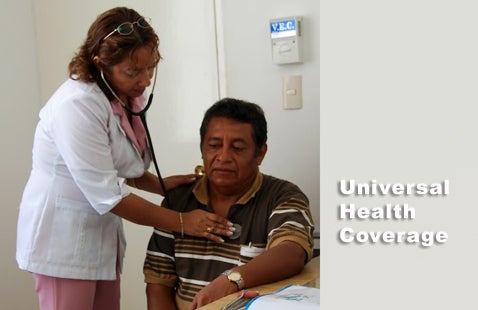

Research carried out in six countries in Latin America and the Caribbean shows that progress toward universal health coverage has coincided with some improvements in health equity, but that significant inequities in health status and access to health care persist.
Studies in the latest issue of the Pan American Journal of Public Health show progress but also continuing challenges in reducing health inequities
Washington, D.C., 15 March 2013 (PAHO/WHO) — Research carried out in six countries in Latin America and the Caribbean shows that progress toward universal health coverage has coincided with some improvements in health equity, but that significant inequities in health status and access to health care persist.

The research, carried out in Brazil, Chile, Colombia, Jamaica, Mexico and Peru, is presented in a special section on "Equity in Health Systems" in the latest issue of the Pan American Journal of Public Health.
"These studies provide important evidence to inform policies on the evolution of income-related inequality in health outcomes and health services utilization and access in these countries' health systems," writes Dr. Carissa F. Etienne, Director of the Pan American Health Organization (PAHO), in an editorial accompanying the research.
The six countries studied are among a growing number of countries in the Americas that have significantly expanded health coverage in recent years. Using household survey data, the studies examine health status, utilization of health services, income and other socioeconomic indicators to detect changes in health inequities in these countries in recent years.
Among the key results are the following:
- In Brazil, the poor reported worse health status than the better-off, while the wealthy reported more chronic diseases. Overall, income-related inequality in the use of medical and dental care is gradually declining, a trend associated with pro-equity policies and programs such as the Community Health Agents Program and the Family Health Program.
- In Chile, inequities in health service utilization have declined over time. Significant income inequality in the use of specialized and dental services persists and calls for attention from policymakers. Overall, the authors conclude that the pattern of health-care utilization is consistent with policies implemented and is trending in the intended direction.
- Colombia has made important progress in equity with regard to social health insurance affiliation, access to medicine and curative services, and perception of the quality of health-care services. Yet important gaps remain that affect poorer populations, especially their perception of their own health conditions and their access to preventive medical and dental services.
- In Jamaica, income-related inequalities in health status and health care have increased, and those who need health services most are using them least—despite measures taken to address health inequity. The findings suggest a need for more innovative programs geared toward improving health equity in the country.
- In Mexico, health-care utilization patterns improved from 2000 to 2006, but no significant changes in income-related health and health-care inequity were found. The evidence supports the idea that increasing the effectiveness of spending is necessary to ensure that more equitable funding translates into more equitable access to services and more equitable health outcomes.
- In Peru, inequity in the use of preventive services increased slightly between 2004 and 2008, but inequity in the use of curative services declined significantly. Overall, the country has low levels of inequality in health status. Contributing to the positive trends were increased household income, reduced economic inequality, the Juntos conditional cash transfer program and gradual expansion of Peru's public health insurance, Seguro Integral de Salud.
Another original research article, "Food and nutrition security policy in Brazil: an analysis of resource allocation," shows that government resources allocated to Brazil's National Policy on Food and Nutrition Security (PNSAN) grew 82% between 2009 and 2010, reaching US$15 billion. The largest portion of these funds was invested in the cash transfer program Bolsa Familia.
Finally, a special report on "The National Tuberculosis Research Agenda in Peru, 2011—2014" describes the participatory process involving researchers, program coordinators, officials and academics that led to a national research agenda designed to improve TB control strategies in the country and optimize the use of financial and human resources.
The Pan American Journal of Public Health (PAJPH) is an open-access, peer-reviewed monthly journal of PAHO/WHO. Its mission is to disseminate scientific public health information to strengthen national and local health systems and improve the health of the peoples of the Americas.
Links:
- Pan American Journal of Public Health, February 2013 (Vol. 33, No. 2)
- More information about the Pan American Journal of Public Health
- http://www.paho.org/paho110/
- http://www.paho.org
- https://www.facebook.com/PAHOWHO
- https://www.youtube.com/pahopin
- https://twitter.com/pahoeoc
- https://twitter.com/pahowho
- https://twitter.com/opsoms
Media Contacts:
Leticia Linn, linnl@paho.org , Tel. + 202 974 3440, Mobile +1 202 701 4005, Donna Eberwine-Villagran, eberwind@paho.org , Tel. +1 202 974 3122, Mobile +1 202 316 5469, Sebastián Oliel, oliels@paho.org , Phone +1 202 974 3459, Mobile 202 316 5679, Knowledge Management and Communications, PAHO/WHO—www.paho.org



